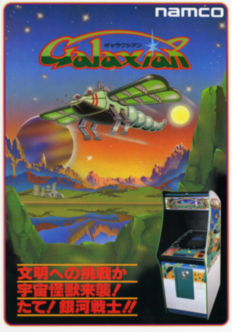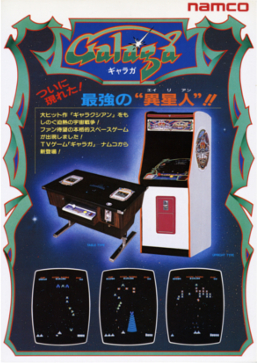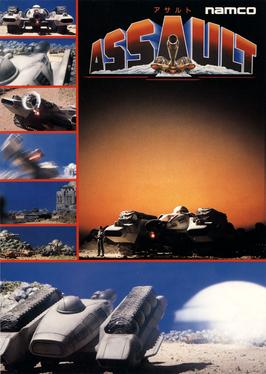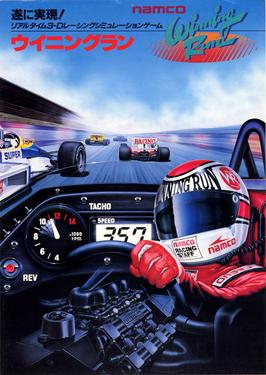
Pole Position is an arcade racing simulation video game released by Namco in 1982 and licensed to Atari, Inc. for US manufacture and distribution, running on the Namco Pole Position arcade system board. It is considered one of the most important titles from the golden age of arcade video games. Pole Position was an evolution of Namco's earlier arcade racing electro-mechanical games, notably F-1 (1976), whose designer Sho Osugi worked on the development of Pole Position.

Namco Limited was a Japanese multinational video game and entertainment company, headquartered in Ōta, Tokyo. It held several international branches, including Namco America in Santa Clara, California, Namco Europe in London, Namco Taiwan in Kaohsiung, and Shanghai Namco in mainland China.
Racing games are a video game genre in which the player participates in a racing competition. They may be based on anything from real-world racing leagues to fantastical settings. They are distributed along a spectrum between more realistic racing simulations and more fantastical arcade-style racing games. Kart racing games emerged in the 1990s as a popular sub-genre of the latter. Racing games may also fall under the category of sports video games.

Yu Suzuki is a Japanese game designer, producer, programmer, and engineer, who headed Sega's AM2 team for 18 years. Considered one of the first auteurs of video games, he has been responsible for a number of Sega's arcade hits, including three-dimensional sprite-scaling games that used "taikan" motion simulator arcade cabinets, such as Hang-On, Space Harrier, Out Run and After Burner, and pioneering polygonal 3D games such as Virtua Racing and Virtua Fighter, which are some of the games besides others from rival companies during that era credited with popularizing 3D graphics in video games; as well as the critically acclaimed Shenmue series. As a hardware engineer, he led the development of various arcade system boards, including the Sega Space Harrier, Model 1, Model 2 and Model 3, and was involved in the technical development of the Dreamcast console and its corresponding NAOMI arcade hardware.
An action game is a video game genre that emphasizes physical challenges, including hand–eye coordination and reaction time. The genre includes a large variety of sub-genres, such as fighting games, beat 'em ups, shooter games, rhythm games and platform games. Multiplayer online battle arena and some real-time strategy games are also considered action games.

Galaxian is a 1979 fixed shooter arcade video game developed and published by Namco. The player assumes control of the Galaxip starfighter in its mission to protect Earth from waves of aliens. Gameplay involves destroying each formation of aliens, who dive down towards the player in an attempt to hit them.

Galaga is a 1981 fixed shooter arcade video game developed and published by Namco. In North America, it was released by Midway Manufacturing. It is the sequel to Galaxian (1979), Namco's first major video game hit in arcades. Controlling a starship, the player is tasked with destroying the Galaga forces in each stage while avoiding enemies and projectiles. Some enemies can capture a player's ship via a tractor beam, which can be rescued to transform the player into a "dual fighter" with additional firepower.

Xevious is a vertically scrolling shooter arcade video game developed and published by Namco in 1982. It was released in Japan by Namco and in North America by Atari, Inc. Controlling the Solvalou starship, the player attacks Xevious forces before they destroy all of mankind. The Solvalou has two weapons at its disposal: a zapper to destroy flying craft, and a blaster to bomb ground installations and enemies. It runs on the Namco Galaga arcade system.
The golden age of arcade video games was the period of rapid growth, technological development, and cultural influence of arcade video games from the late 1970s to the early 1980s. The release of Space Invaders in 1978 led to a wave of shoot-'em-up games such as Galaxian and the vector graphics-based Asteroids in 1979, made possible by new computing technology that had greater power and lower costs. Arcade video games switched from black-and-white to color, with titles such as Frogger and Centipede taking advantage of the visual opportunities of bright palettes.

Tomohiro Nishikado is a Japanese video game developer and engineer. He is the creator of the arcade shoot 'em up game Space Invaders, released to the public in 1978 by the Taito Corporation of Japan, often credited as the first shoot 'em up and for beginning the golden age of arcade video games. Prior to Space Invaders, he also designed other earlier Taito arcade games, including the shooting electro-mechanical games Sky Fighter (1971) and Sky Fighter II, the sports video game TV Basketball in 1974, the vertical scrolling racing video game Speed Race in 1974, the multi-directional shooter Western Gun in 1975, and the first-person combat flight simulator Interceptor (1975).
The following article is a broad timeline of arcade video games.
Point Blank, known as Gun Bullet, or Gunvari in Japan, is a series of light gun shooter games developed by Namco for the arcade, PlayStation and Nintendo DS; the trilogy was first released in arcade in 1994 and was later ported onto the PlayStation. Point Blank DS was released in 2006 for the Nintendo DS featuring 40 challenges from the original series.

Assault is a 1988 multi-directional shooter arcade game developed and published by Namco. It was licensed to Atari Games for release in North America. Controlling a caterpillar-tread self-propelled gun, the player is tasked with completing each of the game's eleven stages while shooting enemies and avoiding projectiles. It uses a twin-stick control layout, similar to games such as Battlezone. The plot involves the human race searching for new planets after Earth reaches its maximum population - after discovering an exo-planet 35,000 light years away from the Milky Way, they enslave the planet's natives and take control, leading to the planet's native population vowing to abolish the humans and bring peace to their world. The protagonist who rides the aforementioned self-propelled gun which players control, is one such native.

Ridge Racer is a 1993 racing video game developed and published by Namco. It was released initially on the Namco System 22 arcade system board and ported to the PlayStation console in 1994. It is the first title in the Ridge Racer series released for arcades and home consoles.

NebulasRay is a vertical-scrolling shooter arcade game developed and released by Namco in 1994. Players take control of a starship named the Fighting Ray through a series of levels in its mission to eradicate the universe of an intergalactic organization named the Master Force. It is noteworthy for its usage of pre-rendering, where 3D models are converted into 2D sprites, creating the illusion of a 3D world.

F-1 is a 1976 electro-mechanical arcade racing game developed and published by Nakamura Manufacturing Company (Namco), and distributed in North America by Atari, Inc. The player uses a steering wheel to control a Formula One racer, which must avoid collision with other vehicles. The game uses a miniature diorama with small, plastic cars to represent the player's car and opponents on a physical, rotating track, while also featuring a projector system and lighting tricks to create the illusion of racing.
Light-gun shooter, also called light-gun game or simply gun game, is a shooter video game genre in which the primary design element is to simulate a shooting gallery by having the player aiming and discharging a gun-shaped controller at a screen. Light-gun shooters revolve around the protagonist shooting virtual targets, either antagonists or inanimate objects, and generally feature action or horror themes and some may employ a humorous, parodic treatment of these conventions. These games typically feature "on-rails" movement, which gives the player control only over aiming; the protagonist's other movements are determined by the game. Games featuring this device are sometimes termed "rail shooters", though this term is also applied to games of other genres in which "on-rails" movement is a feature. Some, particularly later, games give the player greater control over movement and in still others the protagonist does not move at all. On home computer conversions of light-gun shooters, mouse has been often an optional or non-optional replacement for a light gun.

Winning Run is a first-person arcade racing simulation game developed and published by Namco in late December 1988 in Japan, before releasing internationally the following year. The player pilots a Formula One racer, with the objective being to complete each race in first place, all while avoiding opponents and other obstacles, such as flood-hit tunnels, pits and steep chambers. It was the very first game to run on the Namco System 21 arcade hardware, capable of 3D shaded polygons.
Electro-mechanical games are types of arcade games that operate on a combination of some electronic circuitry and mechanical actions from the player to move items contained within the game's cabinet. Some of these were early light gun games using light-sensitive sensors on targets to register hits, while others were simulation games such as driving games, combat flight simulators and sports games. EM games were popular in amusement arcades from the late 1940s up until the 1970s, serving as alternatives to pinball machines, which had been stigmatized as games of chance during that period. EM games lost popularity in the 1970s, as arcade video games had emerged to replace them in addition to newer pinball machines designed as games of skill.

An arcade video game is an arcade game where the player's inputs from the game's controllers are processed through electronic or computerized components and displayed to a video device, typically a monitor, all contained within an enclosed arcade cabinet. Arcade video games are often installed alongside other arcade games such as pinball and redemption games at amusement arcades. Up until the late 1990s, arcade video games were the largest and most technologically advanced sector of the video game industry.













